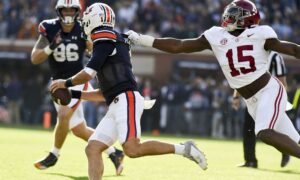Dynasty Debate: Martavis Bryant vs. Jarvis Landry

Our latest debate focuses on two sophomore receivers many hope truly break out this season – Martavis Bryant and Jarvis Landry. While both showed flashes of brilliance last season, they each also have obstacles to overcome in order to become weekly stars in dynasty leagues. We debate which one has the best chance to be successful in the long run.
The Case for Martavis Bryant
We view players like Amari Cooper and Sammy Watkins as stars before ever playing an NFL snap. The hype surrounding these “can’t miss” talents makes them so popular our mothers could pick them out of a lineup. Their shine casts shadows of doubt on prospects whose skills are still raw. Prospects like Martavis Bryant dwell in these shadows.
During his time at Clemson, he was an afterthought to teammates DeAndre Hopkins and Watkins, who took turns scorching the ACC for over 5,000 yards and 55 touchdowns combined. Despite being the most physically gifted of the three receivers, Martavis didn’t assume a starting role until his junior year, turning in a subpar 42 catches for 828 yards and seven touchdowns. The only exceptional statistic in Bryant’s collegiate career was his “Reception to Touchdown Ratio.” From 2011 through 2013, Bryant converted 13 of his 61 catches for touchdowns, a 5:1 mark. An impressive feat, yet it pales in comparison to the production of his receiving mates.
Both Hopkins and Watkins left Clemson as underclassmen boasting resumes worthy of first round selections. Despite failing to match his comrade’s success, Bryant followed Watkins to the NFL, leaving Clemson after three seasons in 2014.
In the run-up to the draft, Bryant’s technical flaws overshadowed his physical gifts in the eyes of evaluators. Drops, double-catches, poor route running, lazy run blocking, an inability to beat press coverage and questionable work ethic were all frequently mentioned defects in his game. Bryant heard the doubters, and responded the way a professional would – he went to work.
[am4show have=’g1;’ guest_error=’sub_message’ user_error=’sub_message’ ]
Leading up to the draft, Martavis sought instruction and guidance from NFL legend Cris Carter. He familiarized himself with route concepts he had never run in the Tigers spread attack. At the combine, he led his position group in the bench press, hoisting 16 reps, answering questions about his strength in the process. His 40 yard dash was blazing as expected. He demonstrated surprising agility in the shuttle drills. There was talk he could be selected as high as the second round. However, his name wasn’t called until pick 118 in round four by the Steelers. It seemed Bryant had finally escaped the shadow of the best wide receiver in college football, only to land in the shadow of perhaps, the best wide receiver in the world.
The Steelers had been without a deep threat since Mike Wallace left for Miami in 2013, a role naturally suited to Bryant’s skill set. When the final 53-man roster was named, he found himself at the bottom of the depth chart, behind Lance Moore, Darrius Heyward-Bey and the Steelers preseason breakout candidate heading into 2014, Markus Wheaton. A gameday inactive through the first six weeks, Bryant finally dressed for action in a week seven tilt against the Texans. Pittsburgh had a 3-3 record and was flirting with last place in the division. From the moment Bryant was injected in the line-up, the Steelers offense transformed into one of the most dominant units in the NFL. They scored fewer than 27 points just twice in their final ten games, winning eight of those matchups. The rookie Bryant averaged over 21 yards per reception over this stretch, scoring eight touchdowns on just 26 catches. His big play ability was the perfect complement to Antonio Brown’s dominance underneath and the dual threat ability of Le’Veon Bell, leaving defenses to pick which poison they’d allow to beat them.
Entering 2015 off-season, Martavis took up mixed martial arts to improve his hand fighting with defensive backs aiming to jam the receiver before he could unleash his trademark speed. Since entering the league a lean 205 lbs, Bryant added 20 lbs of muscle to better handle the punishment dished out in the open field. He spent time with Ben Rothlisberger polishing his route running, in pursuit of elite status. The light has come on and it is brighter than ever.
His second season in the league promises to be his best yet. The attention defenses pay to Brown and Bell will leave Bryant in many favorable situations. They will face as many as ten of the top cornerbacks in the league, players like Aqib Talib, Joe Haden, Richard Sherman, Vontae Davis, Patrick Peterson and Brandon Flowers, whose attention will be solely focused on the All-Pro Brown. While these teams game plan to mitigate the havoc Antonio creates, Bryant will be checked by lesser defenders, ill-equipped to handle his combination of size and speed. Ben Rothlisberger, in the prime of his career, is the perfect strong armed passer to take advantage of Bryant’s skills. It’s frightening to imagine what his 2015 stat line will look like should he continue to score on every fifth pass he catches over a full 16 games.
The dedication and work he has devoted to his craft are just the beginning. He is trading the “project” label, for the title of “Playmaker.” He is finally emerging from the shadows, stepping into the limelight of NFL stardom. Dynasty league owners live for players like Martavis Bryant, who can contribute to their title hopes for years.
Now is the time to get on board.
The Case for Jarvis Landry
On a team with wide receivers full of disappointment, there was one player who stood out among all others. From the start, Jarvis Landry was marked as unathletic and people predicted he would be unable to translate his skills from college to the NFL. Limited athletically and role bound, Landry only seems like a ceiling capped receiver for many and despite this, he served as Ryan Tannehill’s go-to-guy and caught 84 passes for 758 yards as a rookie. Career wise, people have already written off Landry as a potential elite wide receiver. His ceiling is assumed to be capped by his slot role as well as his lack of athleticism. However, there have been many wide receivers bounded to the slot role that proved to be elite fantasy assets. Completely different from the super athletic Martavis Bryant, by the end of my argument, I’ll have you reaching for Jarvis Landry like he’s the next Wes Welker.
What people often forget is Landry was only a rookie last year and just how productive he was. Running a Pro Football Reference screening for wide receivers who caught at least 80 passes for at least 700 yards as a rookie yields only six players – Anquan Boldin, Odell Beckham, Michael Clayton, Terry Glenn and Eddie Royal. Efficiency wise as a slot receiver, Landry had the highest catch rate out of all wide receivers that ran out of the slot at least 50% out of all their routes. Not only that, he had an amazing drop rate of only 3.08%. His efficiency was even better than the highly touted rookie Jordan Matthews who also played out of the slot. Jarvis Landry’s rookie production and efficiency are two things no one should ignore when considering between him and Martavis Bryant.
One of Landry’s weak points (pointed out by many), is his low aDOT (average depth of target by Pro Football Focus) of 5.5 yards. Even in Rotoworld’s latest blurg, they stated “Landry’s low aDOT in some ways caps his fantasy ceiling.” This has been proven false by many productive wide receivers with low aDOTs over the past. In 2011, Percy Harvin had an aDOT of 5.9 yards and caught 87 passes for 975 yards. In 2012, Percy Harvin, with an aDOT of 4.3 yards went on to catch 62 balls for 677 yards in just nine games. In 2009, Wes Welker caught 123 passes for 1,348 yards with an aDOT of 5.9 yards. The low aDOT shouldn’t be scaring you away from Landry, but rather more an indicator of the type of player he will be.
Another supposed weakness of Landry is his athleticism, or lack thereof. According to Player Profiler, Landry ranks in the 18th percentile in height adjusted speed, 1st percentile in burst score, and 0th percentile in agility. To be honest, these should be scaring, but athleticism is only a means to production, not a necessity.
Here in the table below are two players, Jarvis Landry and Player X:

Player X is quicker than Jarvis Landry, but worse in speed and explosion categories. Even if he was a bit quicker than Landry, no one would be going crazy to call him athletic, or even average. However, by his first season as a starter, he went on to catch 112 receptions and 1,175 yards as well as eight touchdowns. At this point, you’re probably wondering who this player X is, unless you know already. Player X is the ultimate slot receiver who everyone strives for – Wes Welker.
When faced with the decision between Jarvis Landry and Martavis Bryant, the decision should be obvious. Jarvis Landry’s rookie production was historic and his efficiency was elite. Not only that, the concerns about Landry shouldn’t be reason for fear. Productive players with low aDOTs such as Percy Harvin and Wes Welker have proven to be elite and productive fantasy assets in the past. Landry’s horrid measurables also are just as good if not better than Wes Welker, who was an elite performer in his prime. Don’t let yourselves be taken in by fancy measurables and the playmaking by Martavis Bryant, but take the super-efficient and productive Jarvis Landry instead.
So, who would you rather have? Jarvis Landry or Martavis Bryant? Let us know in the comments below.
[/am4show]
- Dynasty Capsule: Seattle Seahawks - January 17, 2018
- FanDuel Bargains: Week Five - October 8, 2017
- IDP Report Card: Week 4 - October 8, 2017


































































